Michael and Gail were not particularly looking to purchase a Hunter Legend 35.5 in early 2020. But they were searching through sailing magazines and websites to find an affordable sailboat with a roomy interior and good sailing ability. They’d already co-owned boat and chartered together so the goal was to expand their sailing horizons on the waters of the British Columbia coast.
They retired just before COVID and were visiting Vancouver Island when they learned of a pending sale on a 1993 Hunter 35.5 Legend in Sidney, B.C. Inspection and negotiations were successful, and in March of 2020 Michael and Gail set off for a 4-month coastal cruise along the British Columbia coast in a nearly pristine Atalanta. Self isolation at it’s best!
HISTORY
The history of Hunter Marine is well known. Henry Luhrs established it in the early 1900’s when he began building small fishing boats, then the company started constructing custom-built pleasure craft in 1948. Eventually, Hunter Marine expanded into production boats in the early 1950s. With a focus on mass production to reduce costs, Luhrs found success where others floundered.

Over the years, the family purchased and sold various divisions of the company and stayed abreast of current design features in the boat production industry. From dinghies to 50+ ft. yachts, innovative designs moved from the drawing board and out the factory door. Model lines were established and updated as the years went by.
The Legend series focused on a roomy interior in a strong, lightweight hull. Numerous variants up to 45 ft. emerged from the factory. The smallest of that series, the Hunter 34, enjoyed a successful 4-year production run and was replaced with the development of the Legend 35 in 1986. Modifications to the deck layout and interior accommodations updated the designation to the Legend 35.5 in 1989. Production ran for 6 years and ended in 1995.
CONSTRUCTION

Construction of the Legend 35.5 follows Hunter’s established method of solid laminate fiberglass hulls with an internal fiberglass grid system. The deck is balsa cored with plywood reinforcing where deck fittings are attached. The deck/hull joint is an outward turning flange with an aluminum toe rail bolted through the flange. Hunter was an originator of the fiberglass structural grid system, electing to keep hulls light and dependent on the robust grid to add strength and stiffening. The concept appears to have worked; there’s few indications that the grid system ever failed in normal use. However, the grid does make it difficult to access all parts of the hull internally. This could prove to be a problem should the hull be damaged in a grounding or collision.
Considering that this is a production boat with a focus on keeping costs low, I found the fiberglass detailing very acceptable, particularly when exploring hidden portions in lockers and cabinets. The interior woodwork is nicely detailed and appropriate for a production boat. The balance of wood and white gelcoat makes for a welcoming interior.

An overall length of 35’ 7” (10.85 m) with a maximum beam of 11’ 9” (9.09 m) place well aft of midships makes for a roomy hull. The Legend 35.5 design saw the deep fin keel option available on the 34 dropped. All 35.5’s were launched with the shallow 4’6” (1.37m) winged bulb keel. Displacement is around 13,000 pounds (5,900 kg). Although the design focus was on a cruising boat, the Legend 35.5 with its 569 sq. ft. (53 m2) standard sail area has the potential for being a quick boat.
DECK AND RIGGING
Atalanta, the 1993 Hunter 35.5 Legend of this review, is equipped with a 7/8” Isomat double spreader mast with wire rigging of the traditional style (with backstay), not the B&R rigging often associated to Hunter yachts. The chainplates are well inboard with single deck entry points, secured to the hull’s grid system. The split backstay allows for easy tensioning of the forestay. The Harken furling drum is mounted below deck in the deep anchor locker, a welcome solution to the drum interfering with anchoring equipment at the bow. With the stays in a single plane, and no factory provisions for a baby stay, there may be a tendency for the mast to pump in choppy seas. A solid vang supports the boom. From the factory, the Legend 35.5 was equipped with the Dutchman furling system with a traditional sail cover for the fully battened main. More on this later.
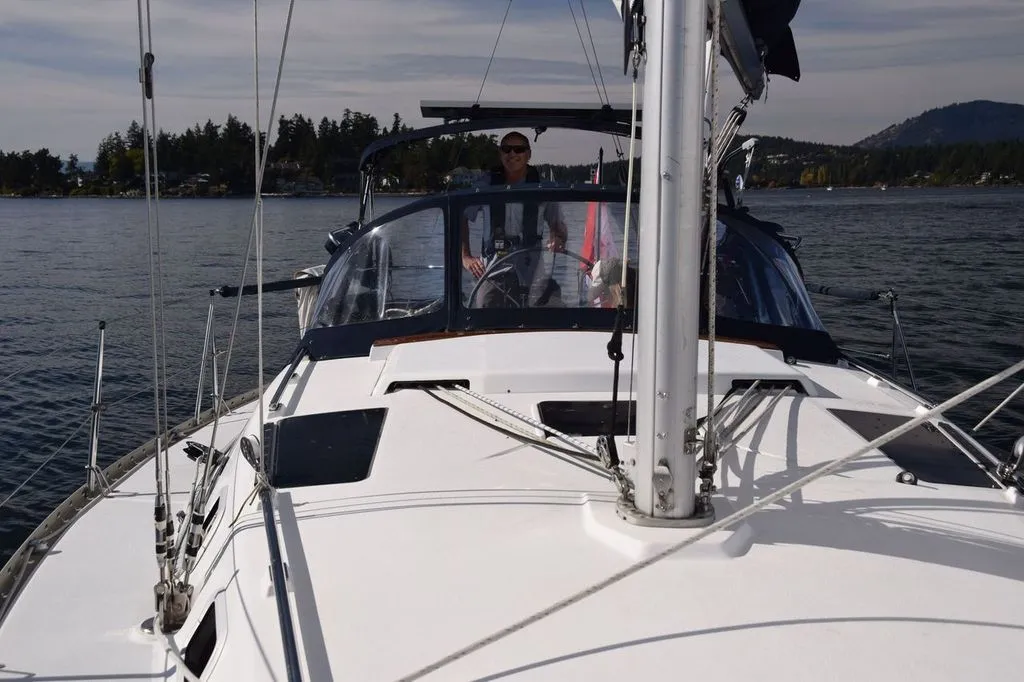
All halyards are internal in the mast, exiting through turning blocks at the base. This makes pumping the sails up the mast to assist in a rapid hoist impossible. All sail control lines are led back to the cockpit through deck organizers that are covered with a removable fiberglass pan. The pan allows for unobstructed deck footing while working with the main, a most welcome feature. 4-gang line stoppers mounted on each side of the companionway lead to a pair of Andersen 40ST winches to assist with control. From the factory, the mainsheet track is just forward of the companionway. A previous owner has moved this onto a bridge directly in front of the pedestal. Although this makes mainsheet control very handy for the racing skipper, it effectively divides the cockpit in 2 and makes getting around the cockpit very cumbersome. It also eliminated the pedestal mounted cockpit table. Michael likes it there, Gail wants it moved back to in front of the companionway. The discussion is ongoing!
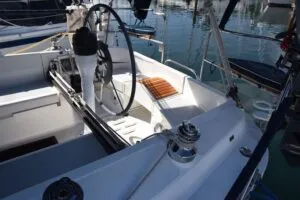
Access to the genoa Barient 45 self-tailing winches mounted on the cockpit coaming is a bit of a stretch from behind the wheel, particularly with the mainsheet traveler in the way. Further back on the coaming, mounted on factory molded pads, a previous owner has installed Andersen 40ST spinnaker winches.
The T-shaped cockpit on the Hunter 35.5 Legend is surprisingly deep for a boat with an aft cabin. The seats are wide enough for lounging and yet allow for bracing on the opposing seat edge. I found the cockpit coaming a little lower than I would consider comfortable as a back support. The 2-angled edge works well when heeled going to windward, but there is a lack of support when the boat is flat. The cabin bulkhead also features a 2-angled surface. The sailing instruments are located on the upper surface. Effective for viewing, but not really comfortable when being used as a backrest.
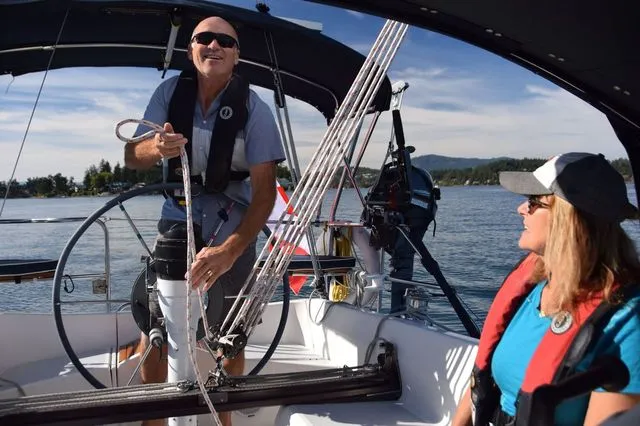
A substantial cockpit locker is located under the starboard side seat and is complemented by 2 small deep lockers on the T behind the wheel. A walkthrough transom has a removable raised seat and separates the 2 lockers. There are additional small lockers on the swim grid/boarding platform at the stern. A swim ladder is permanently mounted on the boarding platform. If the mainsheet traveller was moved out of the cockpit, and the wheel removed when at rest, access to the boarding platform would be excellent. The pushpit has 2 corner seats providing extra seating.
With the stays and genoa track set against the cabin trunk, the side decks are wide and unobstructed. The factory original teak cabin top handrails have been replaced with stainless steel units for low maintenance. The slotted toe rail allows for versatile tie-off points for spring lines or fenders. Double lifelines extend from pushpit to pulpit with gates adjacent to the cockpit.
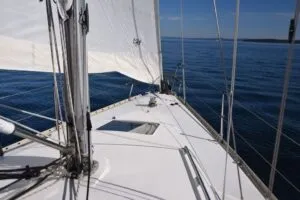
The foredeck is unobstructed right to the Sampson-Lawrence windlass mounted just aft of the anchor locker lid. With the gently sloping cabin top leading to the foredeck, there is plenty of room for sail control work or dinghy storage in this area.

The anchor locker is very deep forward. A platform that covers the forward end of the v-berth shallows the locker at the aft end. Plenty of room for chain and rode—a second Danforth anchor is stored there as well. The Harken furler drum is mounted high and well forward in this locker, not interfering with the chain or rode. A substantial single stainless-steel anchor roller is angled alongside the forestay.
SAILS
The Legend 35.5 came with the Hunter introduced “Cruise Pac” inventory of cruising equipment. This included a full-batten mainsail with the Dutchman flaking system and traditional mainsail cover. Previous owners have dispensed with the Dutchman in favor of lazy jacks and stack pack system for the main sail. Michael enjoys the ease of dropping and flaking the big main with this system. A single-slab reef point on the fully battened North Sails main is controlled with a line leading back to the cockpit.

The U.K. 130% genoa is relatively new. Both sails are in fine form. For downwind sails, Michael has a cruising spinnaker on a Selden top-down furling system.
When asked at what point a reef goes into the main, Michael replied that it was usually when Gail forces the issue! But practically, sailing to windward with winds approaching 18 kn across deck, Michael puts a reef in to keep the boat upright. Excessive heeling pushes the limits of control with the shallow-draft rudder. A deep keel and rudder would be most welcome in cruising grounds that are not hampered by excessively shallow waters.
Going below on the Hunter 35.5 Legend is simply a pleasure. The very low bridge deck does not obstruct passage through the companionway and it’s only 3 steps down into a bright, voluminous cabin. Two large trapezoid skylights over the salon complement the translucent companionway slide, while 7 cabin and 3 hull portlights complement the 6’ 3” (1.91 m) headroom. The oiled teak interior is brilliantly illuminated with natural light. A small amidship deck hatch, large v-berth deck hatch, and the 4 opening portlights provide plenty of ventilation throughout the cabin. The fixed portlights are frameless, set into recesses in the cabin top. Due to minor leaking and plexiglass crazing, these portlights were replaced recently. The fixed portlight over the galley includes a small opening portlight, perfect for venting moisture from the galley range. The overhead is nicely finished in gelcoat with appropriate covers for accessing deck hardware fasteners. Probably not the most stylish of headliners, but very practical. When you enter the main cabin, the galley is to port with the deep double sink near the centerline in a J-shaped configuration. Atalanta came from the factory with a gimbled 2-burner Hillerange natural gas stove and oven. Natural gas is a far safer fuel than propane because it is lighter than air and will evacuate itself through open hatches should a leak occur. Propane will settle into the lowest point of the hull, awaiting an ignition source to ruin your day. Unfortunately, compressed natural gas outlets are few and far between locally, so Michael and Gail have indicated that a conversion to propane is in the future. A substantial, well-insulated top-loading refrigerator is located next to the stove. 2 opening lids provide great access to both the refrigeration and separate freezer compartments. An added bonus is that the entire countertop does not need to be cleared to gain access to fridge or freezer, just slide items over to the closed side. As is usually the case, there is a dearth of counter space for food preparation. Although there are drop-in cutting boards for the sink, a flip-up board would probably be most convenient to extend the counterspace. Storage for galley items is somewhat limited. The fixed galley portlight provides welcome light but does take away additional storage space. There is storage available in small lockers above and below countertop, an open area for plates and bowls, and a stack of drawers adjacent to the deep, double sink. The functioning galley set-up will keep the chef in touch with the cabin guests. On the starboard side of the companionway is the head compartment. Quite a roomy space, it includes the head, vanity with excellent storage capacity, and sit-down shower. A plexiglass splash guard minimizes spray to the vanity but no provision for a shower curtain was visible. Although finished with easy to clean melamine surfaces with teak trim, taking a shower here is going to mean some clean-up time. It wouldn’t take much effort to install a shower curtain to reduce that workload. Two large, fixed ports and a deck hatch provide plenty of light and acceptable ventilation. Moving forward, there is a small navigation table to starboard, just large enough to hold folded charts or the popular cruising atlases. The end of the settee provides seating. This table has fairly deep storage underneath and a comprehensive electrical panel above. The panel is set in its own cabinet installed on the bulkhead. Access to wiring is easily accessible by simply removing the face of the panel. There is very limited space for electronics at the navigation station and placement of such would require considerable thought. Best to have navigation electronics in the cockpit anyway. The salon table is contoured to the settees and surrounds the mast support. A drop leaf on the starboard side allows easy access to the forward cabin. The table height is adjustable and, in the lowest position, forms a double berth. The starboard settee is relatively narrow and wouldn’t be considered a sea berth. With the Hunter’s shallow hull there is very limited storage under or behind the settees. However, nicely finished teak cabinetry at shoulder height provides adequate storage on both sides of the interior. One-in. 1- stainless chainplate rods project down over both settees from the deckhead grid to the substantial hull grid underneath. These will undoubtedly interfere with seating if there is a crowd aboard. The port side settee is L-shaped and extends from the galley to the forward bulkhead. Under the seats are mounted the 6 gal (27 L) hot water tank and natural gas cylinder. Again, not much in the way of storage for cruising supplies. As mentioned earlier, the overhead has an exposed fiberglass box grid athwartship just aft of the mast support, mirrored on the teak and holly sole with the box grid protruding above the cabin sole. It’s a duck-under/step over arrangement for taller sailors! The v-berth is separated from the main cabin by a double door arrangement. With both doors open interior space seems to expand exponentially. Two substantial hanging lockers shoulder this cabin providing plenty of space for clothing. The v-berth is wide at the shoulders although a bit short in length. A couple will need to be friendly with their feet! The 64-gal. (242 L) water tank is located at the aft end of the v-berth. Although there is storage space forward of this tank, the only access is by lifting the mattress—fairly inaccessible. The aft cabin is through a solid door aft of the galley with plenty of access room. The bed is athwartship and substantial in size, certainly a roomy double. There is enough room in the stand-up area for dressing. There are 3 fixed ports against the hull, an opening port into the cockpit and a small opening deck hatch providing plenty of light and ventilation. A hanging locker provides storage for clothing. The cabin sole is teak and holly plywood panels fastened to the fiberglass grid. All panels can be removed for refinishing, replacement or gaining access to the hull. Unfortunately, with this style of floor panel fastening, care has to be taken to ensure panels are really secure. Finding that last squeak can be maddening. The aft 2 panels can be lifted to access shallow storage bins under the sole, which is handy for beverages and canned goods. The 3-cylinder, 27-hp. Yanmar diesel is tucked under the cockpit floor with acceptable access through the removable companionway steps and 2 side panels—1 in the aft cabin and the other in the head. The first step in the companionway, a wide platform with a lid into a shallow storage compartment, is removable and allows excellent access to the top of the diesel. Access to the oil dipstick, raw water strainer and water pump are all acceptable. Engine instruments are on a panel in the cockpit, throttle and gearshift on the pedestal. Engine stop is a mechanical pull located just inside the companionway, which is somewhat inconvenient for the skipper behind the wheel. I would change this out for an electric solenoid stop with a switch on the instrument panel. Battery placement is in the starboard-side stern locker. Atalanta has 4, 6-volt wet cell house batteries and a separate 12-volt starting battery. The battery selector switch, shore power plug-in and shore power breaker are in this same compartment. This is a small, deep locker and working in here is going to be a real challenge. There is not enough room to climb in. Reaching the tops of the batteries is a challenge. The 22-gal. (83 L) fuel tank is located low between the lockers, against the stern of the hull. The factory 14-gal. (64 L) aluminum holding tank, which is prone to internal corrosion, has been replaced with a 16.5-gal. (75 L) plastic tank located just forward of the fuel tank. Ready access to the bilge is somewhat limited to just aft of the mast support and is about 12-in. deep with plenty of room for bilge pumps and switches. The 3 leading keel bolts are also visible. The remaining bolts are under a panel adjacent to the galley cabinet. Cabin heat, a necessity in our Pacific Northwest area, is provided by an Espar D3L forced air system feeding off the diesel tank. There isn’t much in the way of bulkhead space to install cabin heaters such as the Dickenson Newport or Force 10 Cozy Cabin Heater. I joined Michael and Gail on a beautiful fall day off the Sidney waterfront. The winds, unfortunately, were very light, somewhat typical for this region this time of year. The Hunter 35.5 Legend is not a particularly heavy boat for her size and her light-airs performance was quite surprising. In 5 kn of true wind, she drifted along nicely at 3 to 4 kn to windward, the sheeting angles allowing for fairly tight windward work. The wheel was very light and responsive to the touch, tacking though roughly 1200 in the light conditions. In windy conditions, Michael reports that the short rudder (shallow draft) is at the edge of control when heeled excessively. The same holds true when running hard downwind in a significant sea. Michael and Gail’s most recent cruise included sailing up the Central Coast of British Columbia to Bella Bella, a fabulous, remote cruising ground on the exposed west coat of British Columbia. Passages on open ocean water are common and the Legend 35.5 proved herself capable in strong winds and seas with prudent handling. The cockpit is roomy and allows for plenty of movement behind the wheel. Ideal seating for the helmsperson is on the wide coaming with the lifelines as a backrest. The clear view along the side deck is ideal for watching tell-tails and sail shape. In light winds, or under power, Michael favors the pushpit seats while steering with his feet! Engine noise under power is very acceptable with a low level of vibration from the Yanmar. Handling under power is very typical of fin keel/spade rudder designs, the boat goes where it’s pointed. A short turning radius allows for precise control in tight quarters. Under power, Michael cruises along at 2,700 rpm providing 5.5 kn through a MaxiProp, well below the theoretical hull speed of 7.2 kn. With a max RPM of 3,600 there is plenty of power in reserve should the situation require it. Prop walk in reverse is virtually non-existent with the MaxiProp. If you’re looking for a bullet-proof, ocean-going sailboat to follow your dreams to tropical paradise, this is not the boat for you. But if you’re looking for a comfortable, roomy coastal cruiser with the ability to take on ocean waters, the Hunter Legend 35.5 would certainly be worth considering. Time has proven that Hunter’s grid system design and construction techniques have successfully endured what sailors and nature have thrown her way. Like every other boat of this era, the Legend 35.5 has the potential for trouble spots, including water penetration into the cored deck. But routine inspection and maintenance can identify and correct those issues. For her designed purpose and price range, it would be hard to find a better-qualified coastal cruiser.
Hunter 35.5 Legend Courtesy Sailboatdata.com
Sailboat Specifications
Hull Type: Wing Keel
Rigging Type: Fractional Sloop
LOA: 35.58 ft / 10.84 m
LWL: 29.75 ft / 9.07 m
S.A. (reported): 569.00 ft² / 52.86 m²
Beam: 11.75 ft / 3.58 m
Displacement: 13,000.00 lb / 5,897 kg
Ballast: 4,800.00 lb / 2,177 kg
Max Draft: 4.50 ft / 1.37 m
Construction: FG
Ballast Type: Lead
First Built: 1989
Last Built: 1995
Builder: Hunter Marine (USA)
Auxiliary Power/Tanks
Make: Yanmar
Model: 3GM
Type: Diesel
HP: 27
Fuel: 22 gals / 83 L
Water: 64 gals / 242 L
Sailboat Calculations
S.A. / Displ.: 16.53
Bal. / Displ.: 36.92
Disp: / Len: 220.41
Comfort Ratio: 23.97
Capsize Screening Formula: 2
S#: 2.42
Hull Speed: 7.31 kn
Pounds/Inch Immersion: 1,249.03 pounds/inch
Rig and Sail Particulars
I: 42.00 ft / 12.80 m
J: 12.16 ft / 3.71 m
P: 44.08 ft / 13.44 m
E: 14.25 ft / 4.34 m
S.A. Fore: 255.36 ft² / 23.72 m²
S.A. Main: 314.07 ft² / 29.18 m²
S.A. Total (100% Fore + Main Triangles): 569.43 ft² / 52.90 m²
S.A./Displ. (calc.): 16.54
Est. Forestay Length: 43.72 ft / 13.33 m
Sailboat Forum
View All Topics: https://sailboatdata.com/forums/topic-tag/hunter-355-legend/
Create Topic: New Topic +
Latest Topics: Be the first one to create a topic +
ACCOMMODATIONS


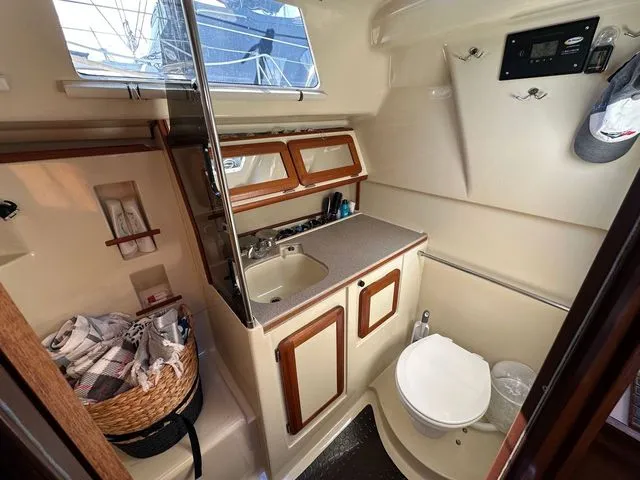

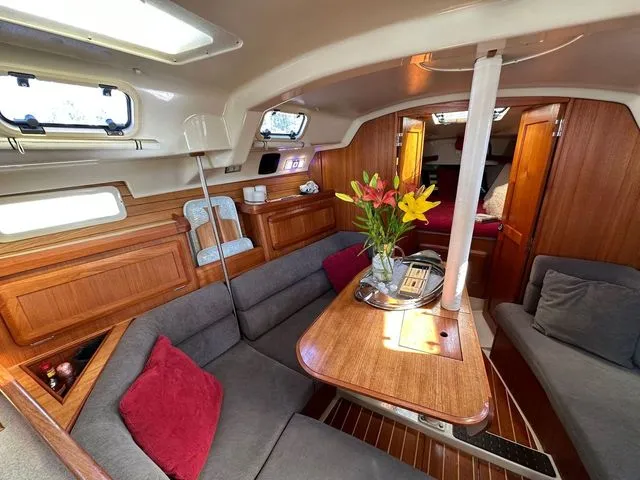

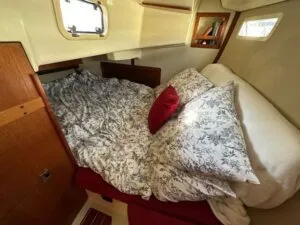
MECHANICAL
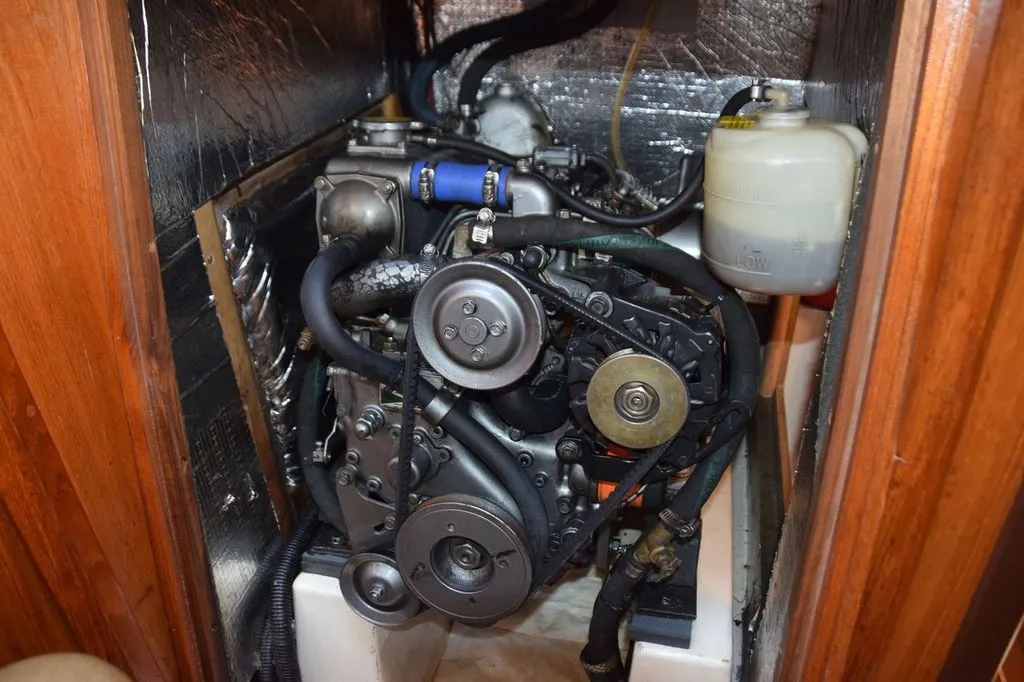
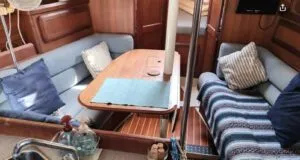
UNDERWAY
CONCLUSION
Market Scan Contact
1990 Hunter 35.5 Sea Lake Yachts LLC
$39,500 USD +1 (346) 572-3891
Seabrook, Texas Yacht World
1993 Hunter 35.5 Jersey Cape Yacht Sales
$44,900 USD +1 (908)867-9641
Island Heights, New Jersey Yacht World
1989 Hunter 35.5 Knot 10 Yacht Sales
$34,900 USD +1 (240) 923-5232
Annapolis, Maryland Yacht World


































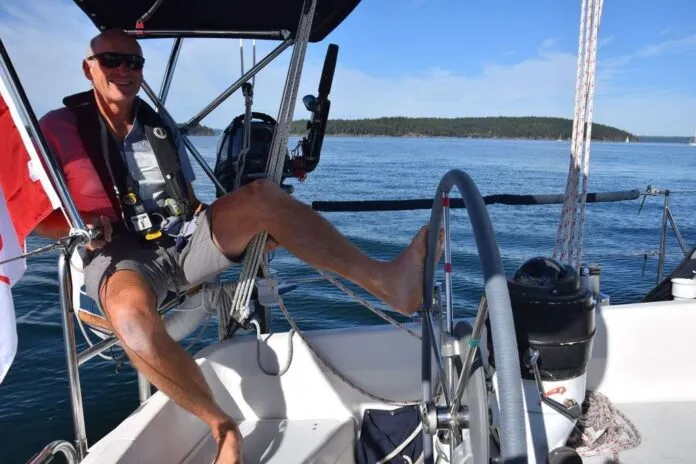





As a bit of a newbie shopping “affordable” cruisers, I find the reference to “looking for bullet-proof”…”not” somewhat opaque; what does the author see as the weaknesses in this regard? Is the lack of tolerance for steep healing angles? Or?